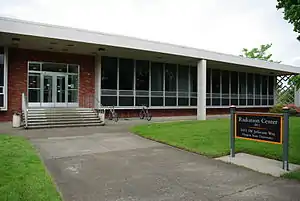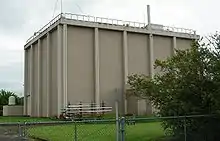Oregon State University Radiation Center
The Oregon State University Radiation Center (OSURC) is a research facility that houses a nuclear reactor at Oregon State University (OSU) in Corvallis, Oregon, United States. The Oregon State TRIGA Reactor (OSTR) serves the research needs of the OSU nuclear engineering department along with other departments (notably medical applications).

About 70% of the research projects at the OSU Radiation Center use the reactor.
Reactor overview

The radiation center is located on the west side of the OSU campus, across the street from the Environmental Protection Agency (EPA) offices and about half a mile from Reser Stadium.[1]
The reactor is a Mark II TRIGA reactor with a maximum thermal output of 1.1 MW and can be pulsed up to a power of 3000 MW for a very short time.[2] The fuel is low enriched uranium.[3] Operation began in 1967.[1][2]
The reactor supported 96 academic courses in 1999. These courses were in chemistry, civil engineering, chemical engineering, geosciences, oceanography and atmospheric sciences, bioresource engineering, honors college and naval engineering disciplines.[2]
The OSU Radiation center supported 126 projects in 2000 with 69% directly involving use of the OSTR.[2] Contracts supporting these projects in 2000 totaled $3 million.[2]
The mission statement of the center is
To serve as the campus wide teaching, research, and service facility for programs involving the use of ionizing radiation and radioactive materials.[4]
Thermal neutron column
There is a large graphite slab that serves the purpose of diffusing neutrons from the reactor which can then be used in Boron Neutron Capture Therapy (BNCT).[5]
Safety
Oregon Department of Energy has coordinated the HAZMAT Radiological Training Courses at the center for HAZMAT response teams throughout the state of Oregon for the last 15 years.[2] Further, instead of only having a Public Safety force on campus and/or local Police, OSU's primary security force are Oregon State Police.
Forensic analysis
The reactor has also used Neutron activation analysis to help with the forensic analysis in a high-profile serial killer case (the I-5 Bandit) and several other cases.[7]
Research
The following are some ongoing projects in conjunction with the reactor:
- Neutron activation analysis
- Radiotracer techniques
- Medical isotope development and production
- Geological age dating
- Neutron radiography
- Thermal hydraulics of nuclear steam systems
- Radiation sterilization
- Radiation dosimeter testing
- Boron Neutron Capture Therapy
- Radiochemical methodologies
References
- ABC News: Oregon State University
- Binney, S.E.; S.R. Reese; D.S. Pratt (February 22, 2000). "University Research Reactors: Contributing to the National Scientific and Engineering Infrastructure from 1953 to 2000 and Beyond". National Organization of Test, Research and Training Reactors. Archived from the original on July 1, 2007. Retrieved 2007-04-07.
- http://www.rertr.anl.gov/RERTR31/pdf/S4-P2%20_Keller.pdf
- Building On A Vision: Research, Testing Facilities & Labs
- Radiation Center
- Radiation Center
- 4-07-98 TV detective series to dust off old technology
